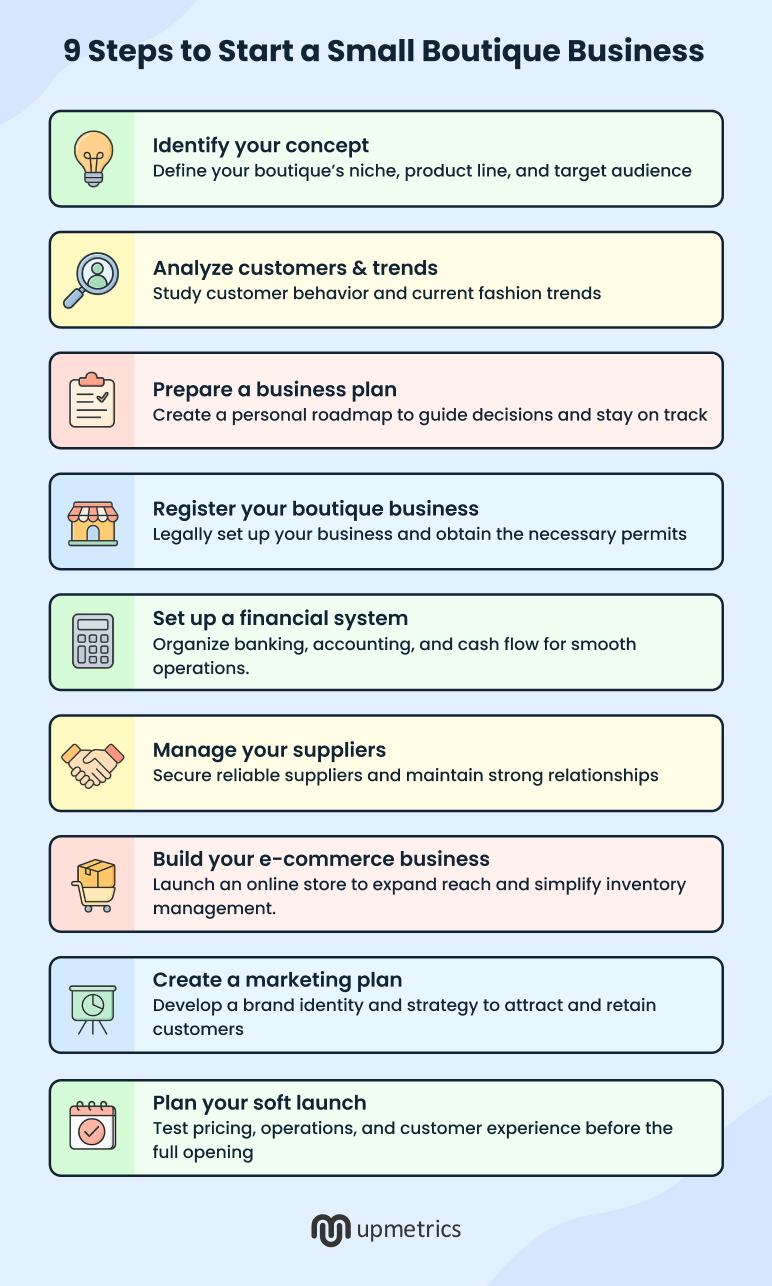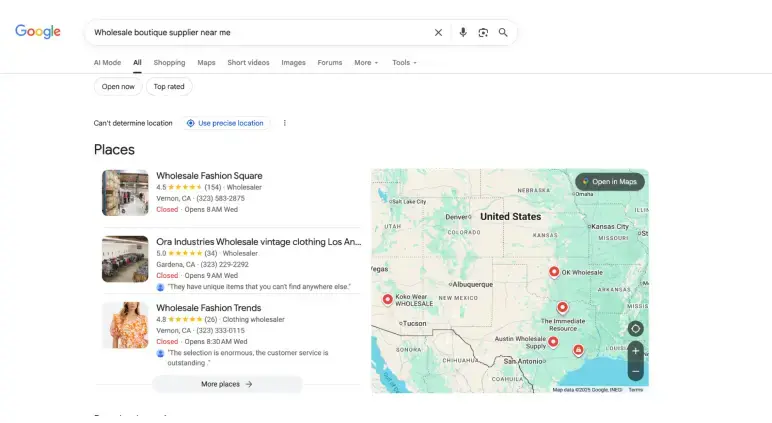There’s no denying that a boutique business is exciting and glamorous. But this business also walks a fine line—one poorly chosen supplier or product line can easily hurt your profits before you even realize it.
Thus, it’s no surprise that the following queries are always on the minds of all prospective boutique owners:
- Where do I even begin?
- Which vendor should I believe?
- Which category should I pursue?
That’s why I’m here to help. I have assisted hundreds of business owners in transforming their concepts into successful stores as a business consultant. Here, I’ll walk you through the process of launching a profitable boutique.
In these nine practical steps, I’ll help you navigate the challenges with confidence and help you set your boutique up for lasting fortune.
Let’s dive in.
Key Takeaways
- Identifying your niche and defining your customer is key to success in a boutique business.
- Creating a unique brand identity makes you stand out in fierce competition.
- A clear business plan, a strong niche, and effective marketing can make a boutique business profitable.
How to start a small boutique business in 2025 (9 Simple Steps)
Boutique is an expensive and trend-driven business; one wrong step can lead to major losses or even closure. Thus, I’ve broken the process into 9 steps to guide your boutique from concept to launch. Let’s begin.

Step 1: Identify your boutique concept and product line
A true boutique isn’t about racks of clothes. It’s about the point of view. Every successful boutique tells a story through its products, style, and curation. That story starts with clarity: what you stand for, who you serve, and what makes your selection different from everyone else’s.
Unlike general clothing stores, boutiques thrive on focus. They don’t try to please everyone; they attract a specific kind of shopper who appreciates taste, craftsmanship, and individuality. That’s why defining your concept early is non-negotiable.
Ask yourself three essential questions before you stock a single hanger:
- What type of products do I truly understand and enjoy curating? (Luxury vintage? Sustainable streetwear? Resort fashion?)
- Who is my ideal customer? (Busy professionals, new moms, travelers, style minimalists?)
- What market gap can I fill? (Are local stores missing size-inclusive options, locally made goods, or bold statement pieces?)
Your answers will shape everything, from inventory to pricing to décor.
Let’s say you love contemporary women’s fashion but notice your city lacks upscale resort wear. That gap becomes your concept: “a coastal-inspired boutique for modern women who want relaxed luxury.” It’s precise, aspirational, and instantly tells shoppers who you are.
Once your concept is clear, build a cohesive product line around it. Each item should feel like it belongs in the same story. For example, a resort-wear boutique might stock:
- Linen co-ords and kaftans
- Straw handbags and sandals
- Lightweight jewelry and summer hats
Every piece complements the rest, reinforcing the brand’s mood and focus. That consistency is what turns browsers into loyal clients—because they know exactly what to expect when they walk through your door.
Step 2: Analyze your customer profile and fashion trends
Thoroughly understanding your clientele and current trends before stocking any items. For example, you don’t have to stock exclusively work clothes in your store just because you’re trying to attract professional women.
You need to first analyze your customer profile. How? Begin by analyzing your customers’ age, income, occupation, lifestyle, and shopping habits.
Ask 15–20 potential customers (friends, coworkers, local community members, or social media followers), simple, open questions:
- What’s missing when you shop locally?
- What challenges do you face while shopping?
- What styles, fabrics, and price points do you prefer?
- From where do you like to purchase (Online or offline)?
Collect their answers in a spreadsheet—this becomes your customer profile and gives instant clarity.
Moreover, spend an afternoon doing what I call a “shop walk.”
Visit 5–7 nearby boutiques or department stores that attract your target audience. Note down:
- Store layout and vibe
- Price ranges
- Displayed bestsellers (what looks sold out vs. untouched)
- Customer footfall and age group
- What’s missing or could be improved
This will help you summarize the competitor’s gap that you can fill.
To grab more analysis and information, prepare a client persona using a survey. I’ve prepared an example, let’s go through it:
Name: Emily
Gender: Female
Age: 32
Income: $70,000 per year
Education: Bachelor’s degree
Marital status: Married
Occupation: Marketing manager in a corporate firm
Buying behavior: Shops 2–3 times per month, prefers curated collections, values quality over fast fashion, follows Instagram influencers for style ideas, responsive to promotions and loyalty programs.
Challenges: Finds it hard to source professional workwear that is stylish, fits well, and is age-appropriate. Moreover, dislikes overcrowded stores and inconsistent sizing.
Demographics: Urban, mid-level income, fashion-conscious, time-sensitive shopper.
Use Google Trends to see what styles, fashion, and silhouettes are gaining popularity.
In addition to it, go through social media and focus on customer conversations and behaviour:
- Search hashtags like #workwearstyle or #ootd [your city name] on Instagram.
- Check what your potential customers actually post and engage with.
- Save posts that fit your brand direction
Keep up with local fashion groups or influencers to see what people are actually wearing; this will help you stock items that your clients will truly want.
Step 3: Prepare your boutique business plan
Before you order inventory or sign a lease, get your numbers and goals on paper. And that’s where a business plan comes in. It helps you figure out:
- How much do I need to invest?
- What’s my pricing strategy?
- What if sales slow down?
It helps you see the big picture instead of reacting day by day.
And if you ever want to apply for a loan or bring in an investor, your business plan becomes proof that you’ve done your homework.
If you’re unsure where to start, consider using a ready-made business plan template. Just fill in your details, and you’ll have a complete, polished plan ready in no time.
However, there are simple steps to creating a business plan if you want to start from scratch. Here’s the list of components to add to your business plan:
1) Executive summary
2) Business overview
3) Market analysis
4) Product line and pricing
5) Marketing plan
6) Operations plan
7) Financial plan
8) Goals and milestones
Need help building a business plan?
Let Upmetrics AI create your plan in under 10 minutes
Plans starting from $14/month

Remember, when things get messy, a business plan helps you make smarter decisions. Read how a business plan acted as a mentor to help Sarah make the right decisions and expand her fashion studio company.
Step 4: Register your boutique business and obtain permits
Start by choosing a legal structure. Based on your business needs and requirements, it can be:
- Sole proprietorship
- LLC
- Corporation
Most small boutique owners go with an LLC because it’s easy to set up and keeps taxes simple.
Next, to safeguard your brand, choose a company name that includes your state and check for trademark conflicts. Next, submit applications for the necessary licenses and permits, EIN, and sales tax permit.
Remember, following local and state regulations makes the process simple. By completing this step, you can ensure your boutique operates lawfully and stays out of trouble or shuts down.
Step 5: Set up your boutique financial system
A solid financial system is crucial for any startup because it tracks your expenses, sales, and cash flow. Without financial planning or a system, even profitable boutiques can run into money problems.
So, how will you set up your financial system? Well, I suggest starting with opening a business bank account. A separate bank account dedicated to your business always saves you from the headache of taxes and makes cash flow easier.
Next, to keep your financial books clean and transparent, choose accounting software. There are many software available, which include:
Choose any that fits your business needs and requirements. The reason to set up accounting software is to automate your accounting and taxes.
You’ll not need to sit at the end of every month to calculate your sales, expenses, and earnings. Record your finances in software, and boom, you’ll have all the details ready in minutes.
Now, to keep things under control, you need to create reports—you can create them monthly, quarterly, or annually, depending on your requirements. The reports include profit & loss, balance sheet, and cash flow statement that will guide your decision and track performance.
For that, you can use Upmetrics’ financial forecasting feature, where you will need to answer a few questions, and your reports will be ready in minutes using AI.
Importantly, in the future, if you need to fund your business, having a financial projection ready will provide you with credibility.
Step 6: Secure and manage boutique suppliers
If you don’t secure and manage suppliers properly from the start, every other part of your business can fall apart. That’s why suppliers are known as the backbone of your boutique business.
Thus, here are the steps to secure and manage your suppliers properly:
1) Identify the potential suppliers
The most common and easiest way to find suppliers is 👇

Searching on Google will help you find suppliers quickly, and it often includes:
- Websites
- Reviews
- Contact details
Reading user reviews, looking through the goods, and comparing prices are all made possible by such thorough data. In addition to Google, you can locate suppliers by searching area directories, trade shows, or industrial expos, where you can meet people directly and get a close-up look at the quality of the products.
2) Evaluate reliability and quality
Keep in mind that the foundation of your boutique is your provider. If they send subpar products or postpone deliveries, your clients will notice and you will lose their faith. Ensure that you know who you’re working with before shaking hands.
Here’s how you can verify their reliability:
- Ask their existing clients if they deliver on time
- Check how long they’ve been in the market
- Read their reviews and feedback online
- Visit their warehouse to see how they operate
- Inspect the product quality in person
- Place a small trial order to test their service
By checking these criteria, you’ll get a clear idea of how dependable the supplier is and whether you can trust them with your boutique’s quality standards.
3) Build strong relationships
Communicate with your vendors via chat, phone, or email. Keeping in touch keeps communication open and helps them feel appreciated when you need urgent assistance.
Here are my suggestions to stay connected and maintain a relationship:
- Provide regular feedback and updates
- Make payment as agreed terms
- Acknowledge and appreciate their timely deliveries
- Visit their facility occasionally to understand their operations
Step 7: Build your e-commerce presence and inventory sync
These days, an online store isn’t a nice-to-have—it’s expected. People want to browse and shop on their own time, and if you don’t offer that, you’re leaving sales on the table.
Start simple: pick a platform that works for you, like Shopify, WooCommerce, or BigCommerce, and get your boutique online.
Let me help you with the process to start with Shopify:
- Visit the official site of Shopify
- Click “Start for free”
- Answer the questions about your business
- Make payment
- Upload photos of your products, and Voila! Your online store is ready to roll
The importance of having an online store extends beyond building authority to also expand your business, automate processes, and gain real-time sales insights.
Step 8: Create your boutique brand identity and marketing plan
You need to build a strong brand identity that people instantly recognize—the look, tone, and vibe that make your boutique feel different.
So, how will you make your brand identity unique?
All you need is a clear, consistent marketing plan that connects with your audience instantly. Let’s break down how to do that.
1) Be unique
To make your brand memorable, do something a little different. The objective is to stand apart from the competition to attract more customers. For example, you can start hosting a “try & sip” campaign on a weekday day say every Wednesday.
Where customers could enjoy a glass of wine while trying on new arrivals. It isn’t just about shopping—it’s an experience you’re providing.
2) Use social media
Do you think social media is about clicking photos, making videos, or posting reels? That’s what everyone does. Want to stand out? Do something that makes people stop scrolling.
For example, start a campaign called “Real Women, Real Outfits”. Instead of hiring models, feature actual customers wearing your brand clothes and share short stories about their jobs, lives, and personalities.
It will make your audience feel real, relatable, and instantly build trust. Moreover, you can add emotional touch, share behind-the-scenes moments, or talk about the inspiration behind your pieces.
3) Use traditional marketing tools
Traditional marketing can still be highly effective for boutiques, especially when targeting a specific local audience. This strategy can include:
- Placing newspaper ads aimed at your targeted audience.
- Use billboards in areas frequented by your target customers.
- Hosting events at your boutique and inviting your ideal audience.
- Offering special promotions like referral programs, “buy one get one free,”.
In addition to enhancing your internet presence, these offline initiatives raise local brand awareness.
4) Collaborate with influencers
Partnering with influencers helps your boutique reach a wider audience and build credibility quickly. Focus on those whose followers match your target demographic—women aged 30–40 interested in professional or corporate wear.
In my opinion, use collaborations for:
- Instagram reels and posts showcasing your products in real-life settings.
- Unboxing videos to highlight your packaging and brand identity.
- Sponsored content or giveaways to drive engagement and attract new customers.
Influencer marketing amplifies your brand visibility and creates social proof, making potential customers more likely to trust and visit your boutique.
Step 9: Plan your soft launch and in-store experience
A soft launch lets you test your boutique operations, gather feedback, and fine-tune everything before the full opening. Here’s how to do it effectively:
- Organize preview events: Invite friends, family, and a select group of potential customers to experience your store. Observe how they interact with products and displays.
- Test pricing and merchandising: Monitor which products attract attention and adjust pricing or placement accordingly.
- Offer loyalty cards and referral incentives: Encourage early visitors to return and bring friends.
- Train staff and refine operations: Use this period to ensure your team knows how to assist customers, manage inventory, and handle checkout smoothly.
Keep the first few days controlled and focused. Collect feedback, adjust based on real customer behavior, and create buzz without overwhelming your team or inventory. A thoughtful soft launch increases the chance that your official opening will run smoothly and attract repeat customers.
Scale your boutique from a single store to a brand
Remember, you don’t have to start scaling your boutique from day one. First, focus on making your single store profitable and consistent.
Observe how customers respond:
- Do they like your collection?
- Are your prices right?
- Is there something you need to improve?
Once you’ve refined the experience and built a loyal customer base, then start thinking about expansion.
And scaling doesn’t just mean opening another location, that’s the biggest misconception. Scaling means creating systems that allow your brand to grow without losing its essence.
Here’s how you can do it right:
| How to Scale | Description | Insight |
|---|---|---|
| Build an online store | Create a Shopify or Instagram shop to reach buyers beyond your city. | Aim for 25% sales from online. |
| Go multi-channel | Sell via pop-ups, exhibitions, or local partner stores to test new markets. | Try 2–3 new channels in 6 months. |
| Strengthen brand identity | Keep your logo, tone, and packaging consistent across all platforms. | Target 40% repeat buyers. |
| Systemize operations | Build SOPs for inventory, suppliers, and customer service before expanding. | Prepare 5 key processes. |
| Train your team | Train staff to deliver the same experience everywhere. | Conduct monthly sessions. |
| Expand smartly | Open another store only when your first one is profitable and stable. | Wait for 12 months of profit. |
| Build community | Launch loyalty, referral, and email campaigns to retain customers. | Aim for 60% repeat customers. |
| Avoid this misconception | A unique concept doesn’t guarantee success—strong systems and consistency do. | Execution > Ideas. |
Is a boutique profitable?
Yes, a boutique business is profitable, but success heavily depends upon your business plan, a strong niche, and effective marketing.
The key here is to understand your customer well, build a loyal base, and keep your collections fresh and relevant. This will keep your margins impressive and help you make your boutique profitable.
Here’s my advice to keep your boutique profitable:
- Track your inventory turnover (how quickly items sell)
- Focus on repeat customers through loyalty programs
- Negotiate smartly with suppliers to control costs
The more you optimize these small levers, the more consistent your profits become.
Conclusion
You’re at the point where your boutique is no longer just an idea—it’s about to become real. You’ve laid the groundwork: Defined your concept, scoped your products, lined up suppliers, and set up systems to keep your business running smoothly.
Now comes the exciting part: Bringing it all together and opening your doors.
Launching a boutique is thrilling, but it’s also a moment that tests everything you’ve prepared. Platforms like Upmetrics can help you keep your business plan, finances, and projections organized, giving you clarity and confidence as you take each step.
This is your moment to turn planning into action, passion into profits, and your vision into a boutique people remember.
Step in, launch smart, and make it yours.
The Quickest Way to turn a Business Idea into a Business Plan
Fill-in-the-blanks, AI-assistance, and automatic financials make it easy.

